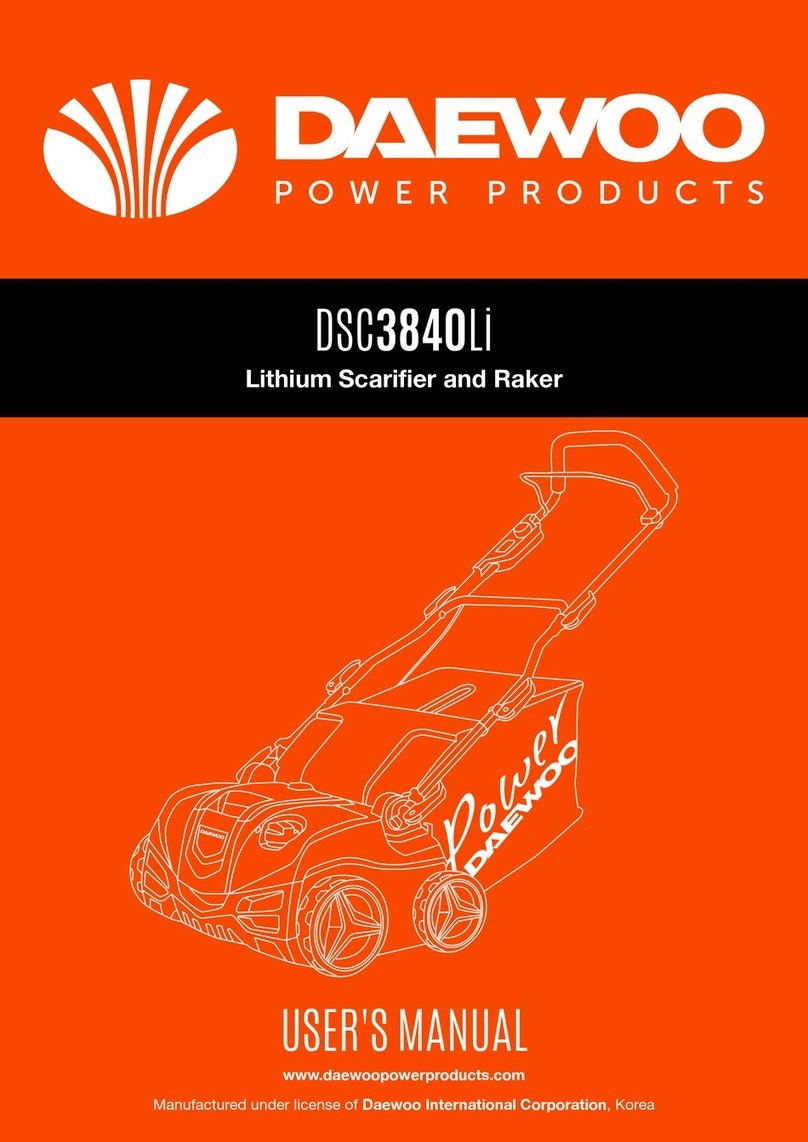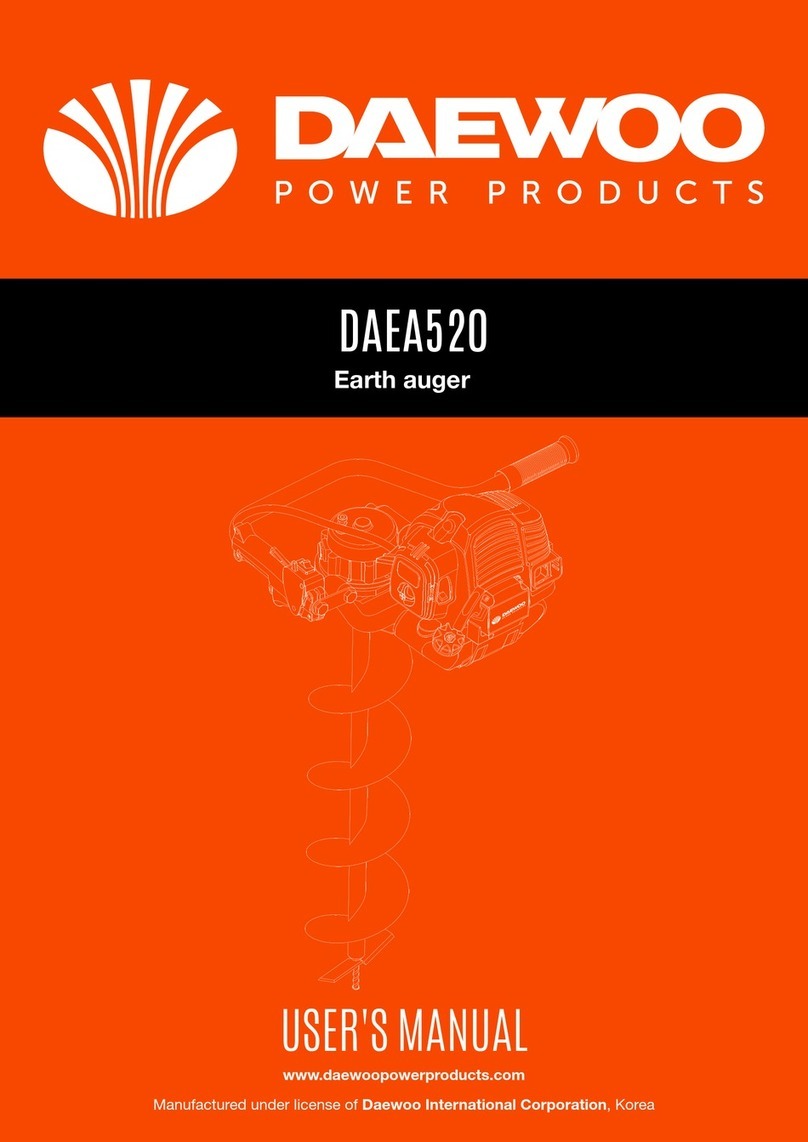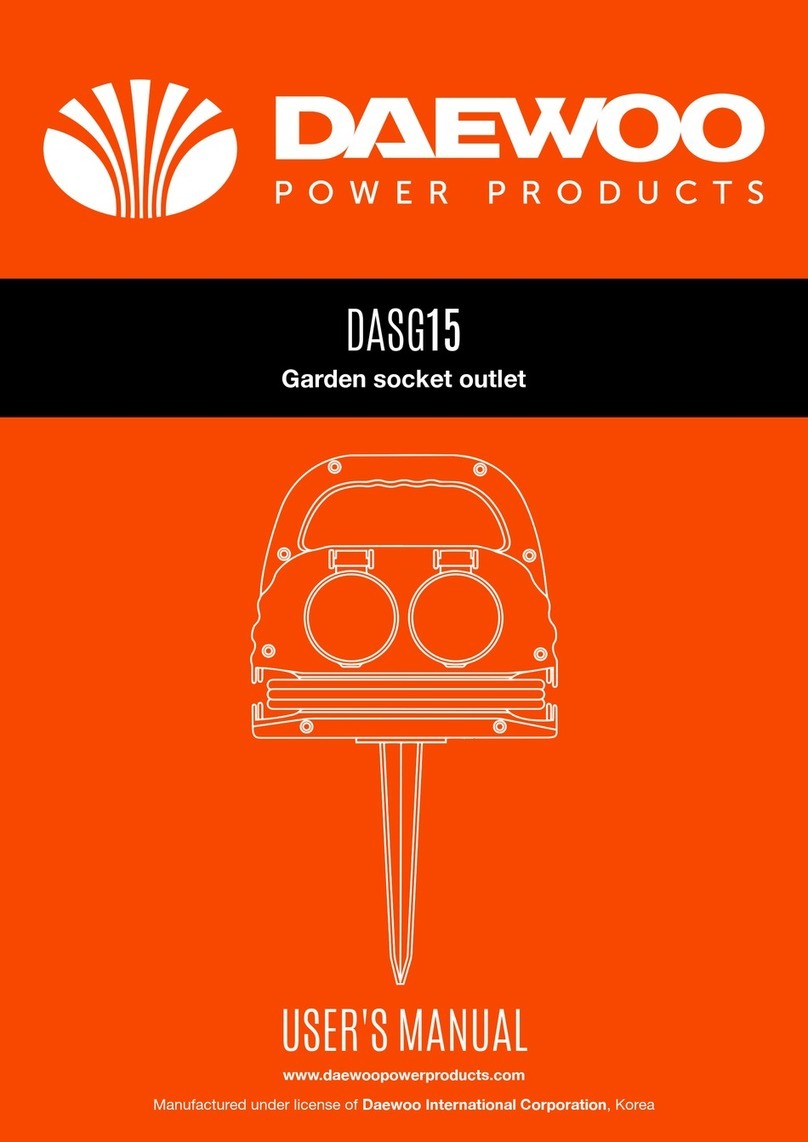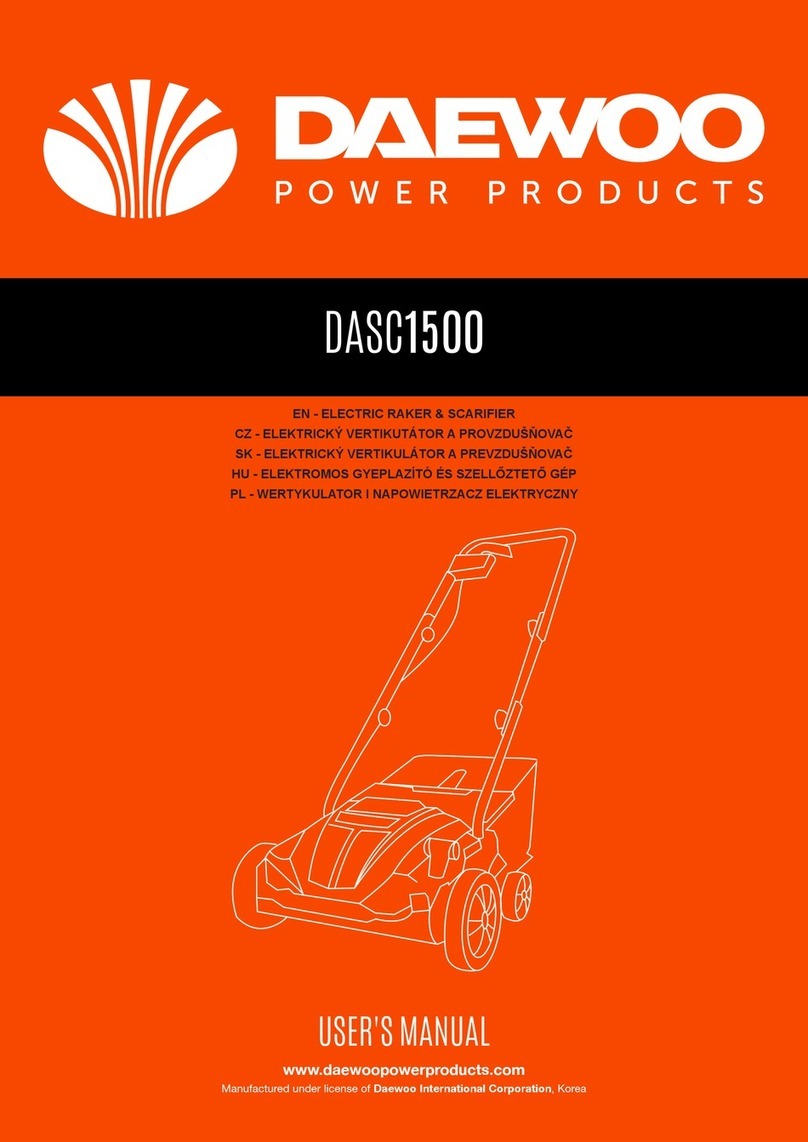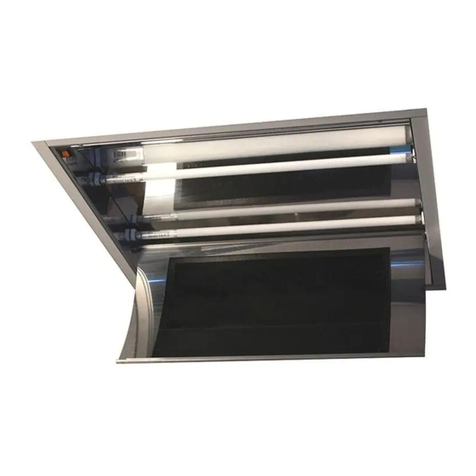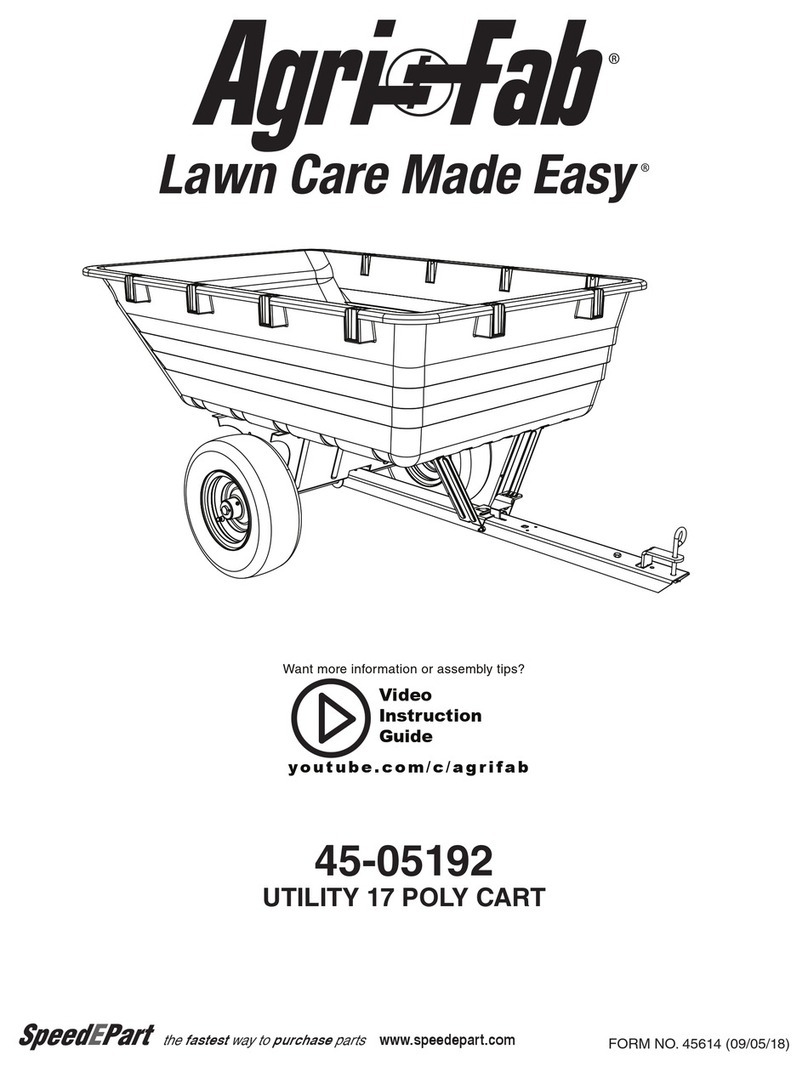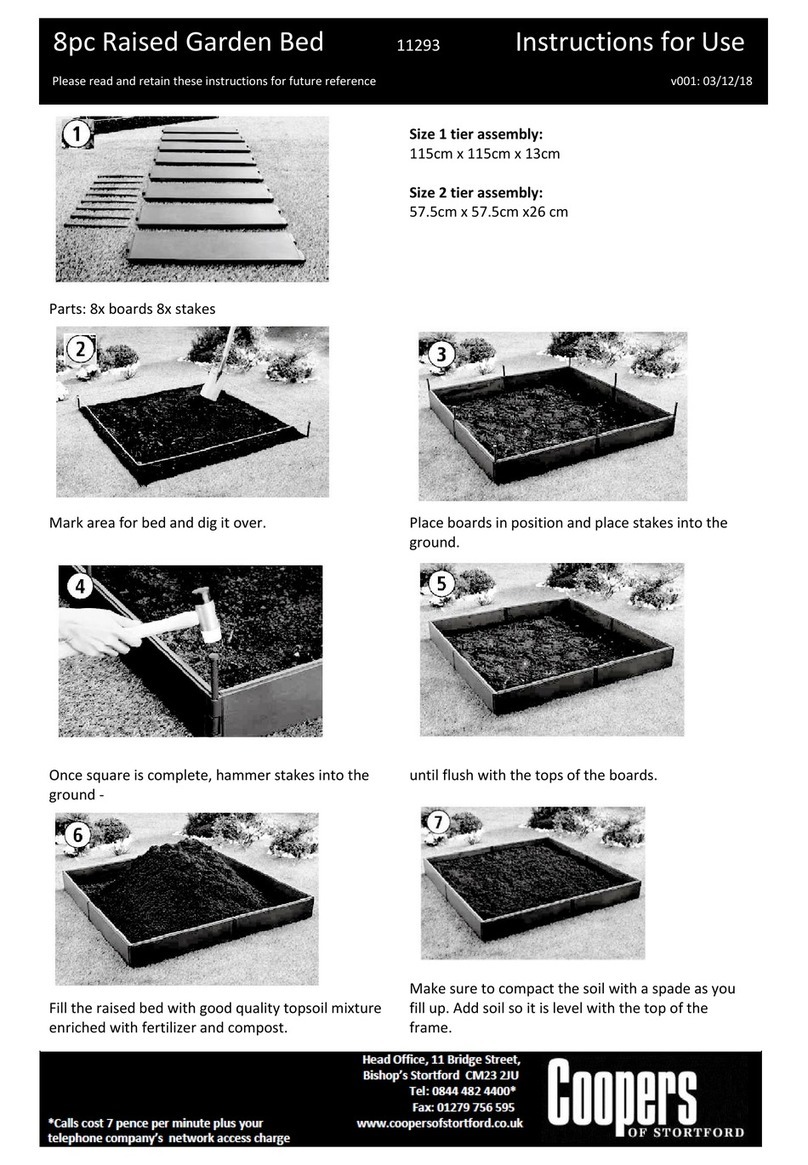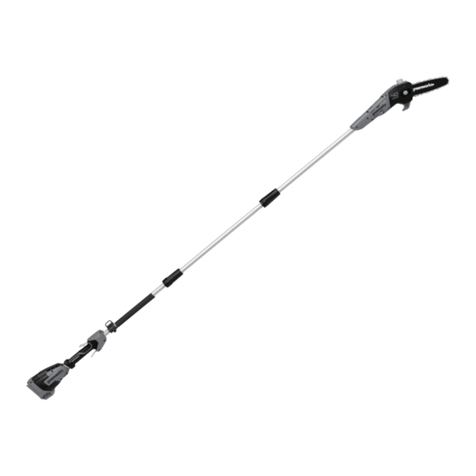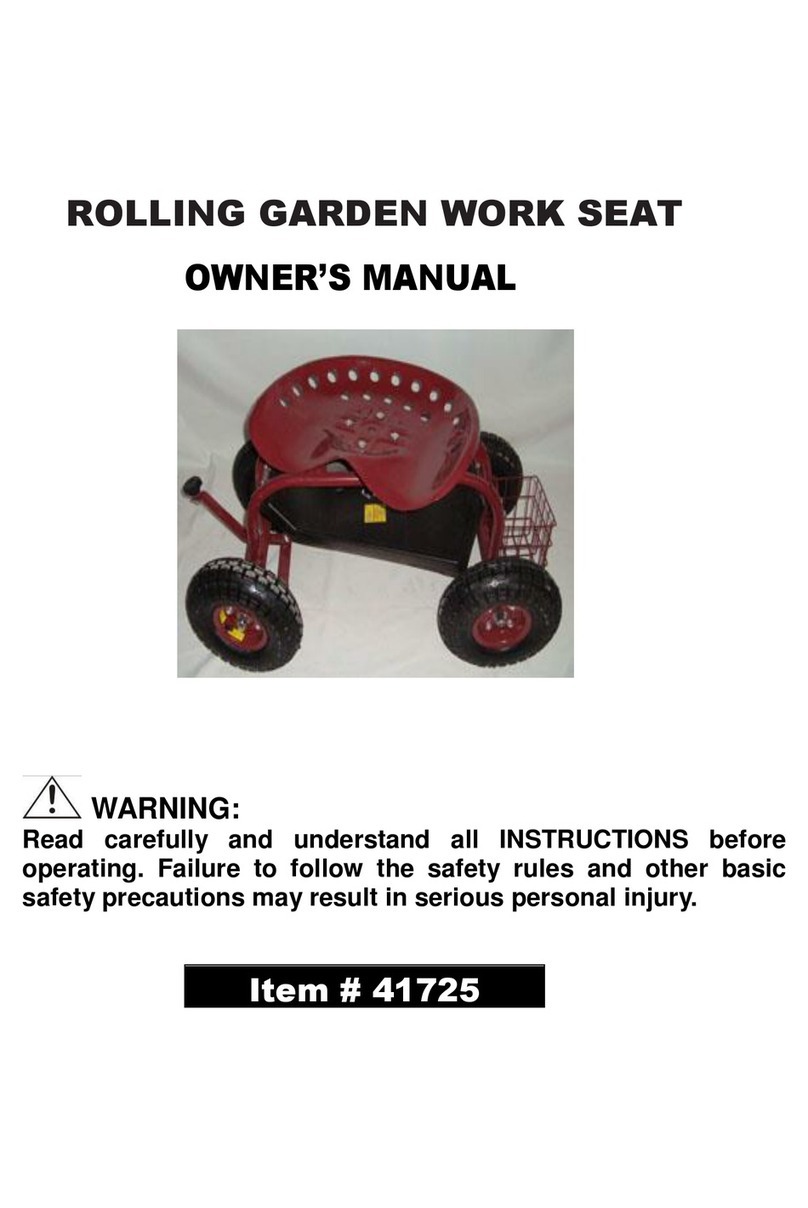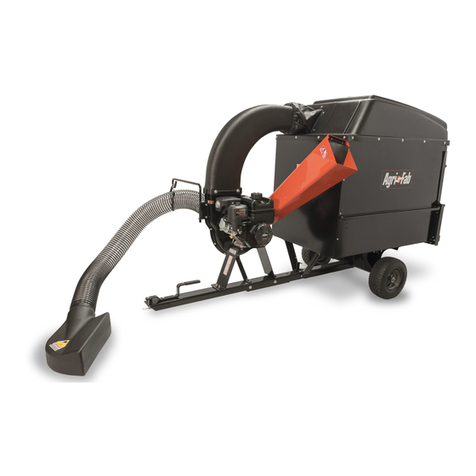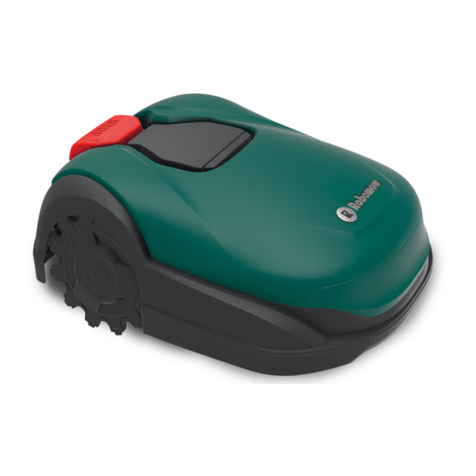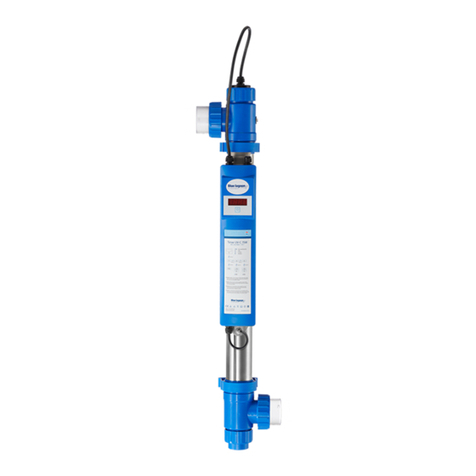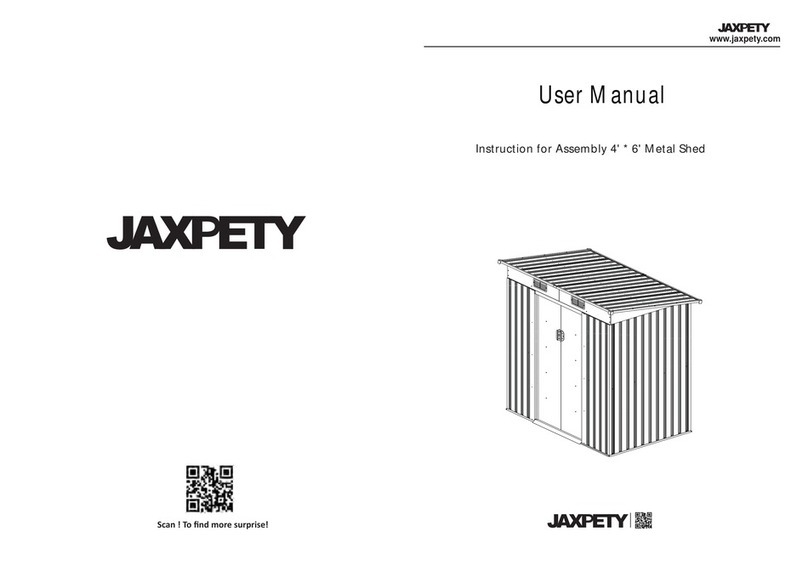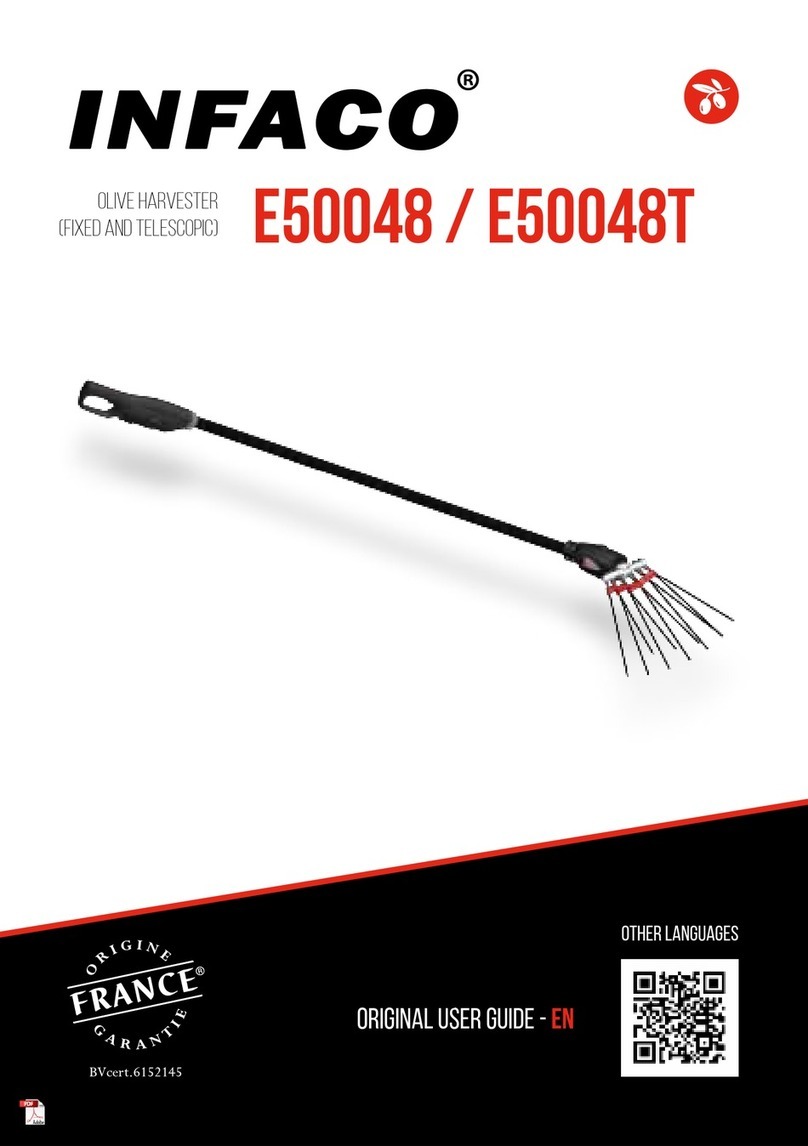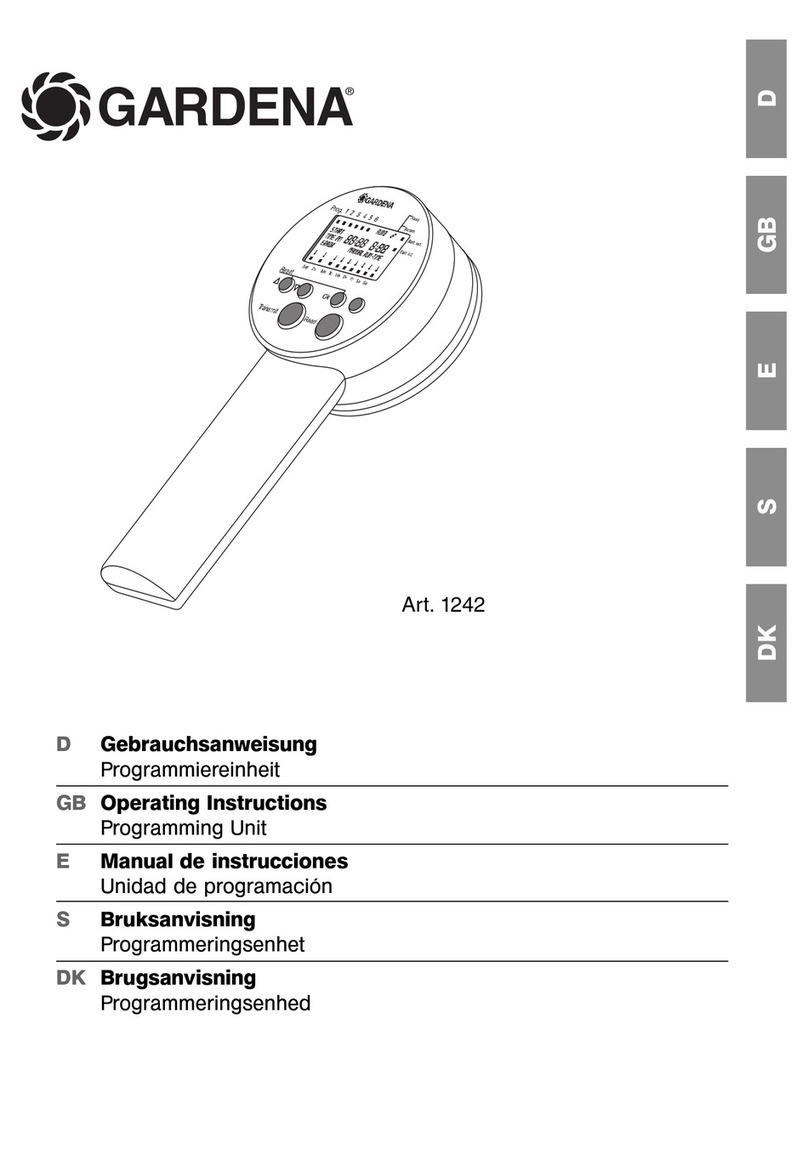Daewoo DALPRS18-1 User manual

Manufactured under license of Daewoo International Corporation, Korea
www.daewoopowerproducts.com
USER'S MANUAL
DALPRS18-1
LITHIUM PRUNING SHEAR

2
INDEX
9
1
.GENERAL SAFETY INSTRUCTIONS FOR ELECTRIC TOOLS ......................................................3
2. SAFETY REGULATIONS ........................................................................................................................ 5
3. LAYOUT AND ITEMS SUPPLIED.............................................................................................................
4. INTENDED USE ....................................................................................................................................... 9
5. BEFORE STARTING THE EQUIPMENT ...............................................................................................
6. OPERATION.............................................................................................................................................10
7. TECHNICAL DATA ..................................................................................................................................13
8. EXPLODED VIEW AND SPARE PARTS LIST
.......................................................................................14
WARRANTY ............................................................................................................................................... 16
12

EN
3
6b
1
2
3
4
5
7
Fig.1b
Fig. 1a
6

4
Fig.2a Fig.2b
Fig.4a
Fig.3
Fig.4b Fig.4c
1
45° 1
1910
12
11

EN
5
1 2 3
45 6 7
Fig.5
2. SAFETY REGULATIONS
General Power Tool Safety Warnings
WARNING: Read all safety warnings and instructions.Failure to follow the warnings and instruc-
tions may result in electric shock, fire and/or serious injury.
Save all warnings and instructions for future reference.
The term “power tool” in the warnings refer to your electric (corded) power tool or battery-operated(-
cordless) power tool.
Explanation of the warning signs on the equipment (see Fig. 5)
1: Warning!
2: WARNING – To reduce the risk of injury, user must read instruction manual!
3: Wear eye and ear and head protection!
4: Wear protective gloves!
5: Wear safety footwear!
6: Do not expose to rain!
7: Keep bystanders away!
1) Work area safety
a) Keep work area clean and well lit. Cluttered or dark areas invite accidents.
b) Do not operate power tools in explosive atmospheres, such as in the presence of flammable
liquids, gases or dust.Power tools create sparks which may ignite the dust or fumes.
c) Keep children and bystanders away while operating a power tool. Distractions can cause you to
lose control.
2) Electrical safety
a) Power tool plugs must match the outlet. Never modify the plug in any way. Do not use any adapter
plugs with earthed (grounded) power tools. Unmodified plugs and matching outlets will reduce risk
of electric shock.
b) Avoid body contact with earthed or grounded surfaces such as pipes, radiators, ranges and
refrigerators. There is an increased risk of electric shock if your body is earthed or grounded.

6
c) Do not expose power tools to rain or wet conditions. Water entering a power tool wil l increase the
risk of electric shock.
d) Do not abuse the cord. Never use the cord for carrying, pulling or unplugging the power tool.
Keep cord away from heat, oil, sharp edges or moving parts.
Damaged or entangled cords increase the risk of electric shock.
e) When operating a power tool outdoors, use an extension cord suitable for outdoor use.
Use of a cord suitable for outdoor use reduces the risk of electric shock.
f) If operating a power tool in a damp location is unavoidable, use a residual current device(RCD)
protected supply. Use of an RCD reduces the risk of electric shock.
3) Personal safety
a) Stay alert, watch what you are doing and use common sense when operating a power tool.Do not
use a power tool while you are tired or under the influence of drugs, alcohol or medication. A
moment of inattention while operating power tools may result in serious personal injury.
b) Use personal protective equipment. Always wear eye protection. Protective equipment such as
dust mask, non-skid safety shoes, hard hat, or hearing protection used for appropriate conditions
will reduce personal injuries.
c) Prevent unintentional starting. Ensure the switch is in the off-position before connecting to power
source and/or battery pack, picking up or carrying the tool. Carrying power tools with your finger on
the switch or energising power tools that have the switch on invites accidents.
d) Remove any adjusting key or wrench before turning the power tool on. A wrench or a key left
attached to a rotating part of the power tool may result in personal injury.
e) Do not overreach. Keep proper footing and balance at all times. This enables better control of the
power tool in unexpected situations.
f) Dress properly. Do not wear loose clothing or jewellery. Keep your hair, clothing and gloves away
from moving parts. Loose clothes, jewellery or long hair can be caught in moving parts.
g) If devices are provided for the connection of dust extraction and collection facilities,ensure these
are connected and properly used. Use of dust collection can reduce dust-related hazards.
4) Power tool use and care
a) Do not force the power tool. Use the correct power tool for your application. The correct power
tool will do the job better and safer at the rate for which it was designed.
b) Do not use the power tool if the switch does not turn it on and off.Any power tool that cannot be
controlled with the switch is dangerous and must be repaired.
c) Disconnect the plug from the power source and/or the battery pack from the power tool before
making any adjustments, changing accessories, or storing power tools. Such preventive safety
measures reduce the risk of starting the power tool accidentally.
d) Store idle power tools out of the reach of children and do not allow persons unfamiliar with the
power tool or these instructions to operate the power tool.Power tools are dangerous in the hands
of untrained users.
e) Maintain power tools. Check for misalignment or binding of moving parts, breakage of parts and
any other condition that may affect the power tool’s operation. If damaged, have the power tool
repaired before use. Many accidents are caused by poorly maintained power tools.
f) Keep cutting tools sharp and clean.Properly maintained cutting tools with sharp cutting edges are
less likely to bind and are easier to control.
g) Use the power tool, accessories and tool bits etc. in accordance with these instruction, taking
into account the working conditions and the work to be performed. Use of the power tool for opera-
tions different from those intended could result in a hazardous situation.

EN
7
h) Store idle Appliances Indoors - When not in use, appliances should be stored indoors in dry,and
high or locked-up place - out of reach of children.
5) Battery tool use and care
a) Replace only with the charger specified by the manufacturer. A charger that is suitable for one
type of battery pack may create a risk of fire when used with another battery pack.
b) Use power tools only with specifically designated battery packs. Use of any other battery packs
may create a risk of injury and fire.
c) When battery pack is not in use, keep it away from other metal objects, like paper clips,coins,
keys, nails, screws or other small metal objects, that can make a connection from one terminal to
another. Shorting the battery terminals together may cause burns or a fire.
d) Under abusive conditions, liquid may be ejected from the battery; avoid contact. If contact acci-
dentally occurs, flush with water. If liquid contacts eyes, additionally seek medical help.Liquid
ejected from the battery may cause irritation or burns.
e) Do not charge appliance in rain, or in wet locations.
f) Do not use battery-operated appliance in rain.
g) Use only the authorized battery.
h) Do not dispose of the battery in a fire. The cell may explode. Check with local codes for possible
special disposal instructions.
i) Do not open or mutilate the battery. Released electrolyte is corrosive and may cause damage to
the eyes or skin. It may be toxic if swallowed.
j) Exercise care in handling batteries in order not to short the battery with
conducting materials such as rings, bracelets, and keys. The battery or conductor may overheat and
cause burns.
6) Service
a) Have your power tool serviced by a qualified repair person using only identical replacement parts.
This will ensure that the safety of the power tool is maintained.
Cordless Garden Pruners Safety warnings
• This appliance is not intended for use by persons (including children) with reduced physical,
sensory or mental capabilities, or lack of experience and knowledge, unless they have been given
supervision or instruction concerning use of the appliance by a person responsible for their safety.
Children should be supervised to ensure that they do not play with the appliance.
• Minors should never be allowed to operate the tool; it should never be left unattended and when
not in use should be stored in a locked place out of the reach of children.
• Don’t use the machine or perform battery charging operations in the rain.
• Don’t leave the machine in rain or wet locations.
• Keep bystanders well away from your work area.
• Be careful not to catch foreign matter between the blades. If the blades are jammed with foreign
matter, immediately switch off the machine. Then remove the foreign matter from the blades.
• Take care, avoid cutting electrical wires that may be hidden.
• Keep your free hand away from the cutting area. Never touch the blades. They are very sharp and
you may cut yourself.
• Be vigilant when operating to ensure that the fingers on the hand used to hold or move twigs to be
pruned are not exposed to the cutting blade.
• Don’t force the machine to make it cut. You could slip and injure yourself or cut something else
unintentionally.

8
• Always check the blades carefully before operation.
• Handle the blades with extreme care to prevent cuts or injury from the blades.
• Remove the battery after each use and before attempting to perform inspection or maintenance.
• Always wear protective gloves when using, adjusting or cleaning the machine.
• Only use the machine for it’s intended use (see “Intended Use”).
Information about the battery
1.The battery pack supplied with your cordless tool is not charged. The battery pack has to be
charged before you use the tool for the first time.
2.For optimum battery performance avoid low discharge cycles. Charge the battery pack frequently.
3.Store the battery pack in a cool place, ideally at 15°C and charged to at least 40%.
4. Lithium-ion batteries are subject to a natural ageing process. The battery pack must be replaced
at the latest when its capacity falls to just 80% of its capacity when new. Weakened cells in an aged
battery pack are no longer capable of meeting the high power requirements and therefore pose a
safety risk.
5.Do not throw battery packs into an open fire. There is a risk of explosion!
6.Do not ignite the battery pack or expose it to fire.
7.Do not exhaustively discharge batteries. Exhaustive discharge will damage the battery cells.The
most common cause of exhaustive discharge is lengthy storage or non-use of partly discharged
batteries. Stop working as soon as the performance of the battery falls noticeably or the electronic
protection system triggers. Place the battery pack in storage only after it has been fully charged.
8.Protect batteries and the tool from overloads.Overloads will quickly result in overheating and cell
damage inside the battery housing without this overheating actually being apparent externally.
9. Avoid damage and shocks. Replace batteries which have been dropped from a height of more
than one meter or which have been exposed to violent shocks without delay, even if the housing of
the battery pack appears to be undamaged. The battery cells inside the battery may have suffered
serious damage. In this respect, please also read the waste disposal information.
10.If the battery pack suffers overloading and overheating, the integrated protective cut-off will
switch o ff the equipment for safety reasons.Important. Do not press the ON/OFF switch any more
if the protective cut-off has actuated. This may damage the battery pack.
11.Use only original battery packs. The use of other batteries may result in injuries, explosion and a
fire risk.
Information on chargers and the charging process
1. Please check the data marked on the rating plate of the battery charger. Be sure to connect the
battery charger to a power supply with the voltage marked on the rating plate. Never connect it to a
different mains voltage.
2. Protect the battery charger and its cable from damage and sharp edges. Have damaged cables
repaired without delay by a qualified electrician.
3. Keep the battery charger, batteries and the cordless tool out of children’s reach.
4. Do not use damaged battery chargers.
5. Do not use the supplied battery charger to charge other cordless tools.
6. In heavy use the battery pack will become warm. Allow the battery pack to cool to room
temperature before commencing with the charging.
7. Do not over-charge batteries. Do not exceed the maximum charging times. These charging times
only apply to discharged batteries. Frequent insertion of a charged or partly charged battery pack
will result in over-charging and cell damage. Do not leave batteries in the charger for days on end.
8. Never use or charge batteries if you suspect that the last time they were charged was more than

EN
9
9.Charging batteries at a temperature below 10°C will cause chemical damage to the cell and may
cause a fire.
10.Do not use batteries which have heated during the charging process, as the battery cells may
have suffered dangerous damage.
11.Do not use batteries which have suffered curvature or deformation during the charging process
or which show other non-typical symptoms (gassing, hissing, cracking,…)
12.Never fully discharge the battery pack (recommended depth of discharge max. 80%) A complete
discharge of the battery pack will lead to premature ageing of the battery cells.
13.Never charge the batteries unsupervised.
3. LAYOUT AND ITEMS SUPPLIED
2.1 Layout (Fig. 1a/1b/4a)
1 Blade – moving
2 Blade – fixed
3 ON/OFF switch
4 Safety lock-off
5 Blade guard
6 Battery
7 Battery charger
8 Cord
9 the blade washer
10 the blade wave washer
11 the blade screw
12 the blade nut
2.2 Items supplied
• Open the packaging and take out the equipment with care.
• Remove the packaging material and any packaging and/or transportation braces (if available).
• Check to see if all items are supplied.
• Inspect the equipment and accessories for transport damage.
• If possible, please keep the packaging until the end of the guarantee period.
Important!
The equipment and packaging material are not toys. Do not let children play with plastic bags, foils
or small parts. There is a danger of swallowing or
suffocating!
• Original operating instructions
• Safety instructions
4. INTENDED USE
This machine is intended for domestic use in pruning branches and plants with a thickness up to 15
mm (hardwood) and 20 mm (softwood).
NOTICE: DO NOT CUT OTHER MATERIAL SUCH AS WIRE, STEEL WIRE, STONE, PLASTIC, AND SO
ON.

10
5. BEFORE STARTING THE EQUIPMENT
5.1 Installing the battery (Fig. 2a/2b)
Press the both side of the battery pack as shown in Fig. 2a and push the battery pack into the
mount provided. When the battery pack is positioned as in Fig. 2b, make sure that the battery pack
latch in place! To remove the battery pack, proceed in reverse order.
5.2 Charging the battery (Fig.3)
1. Take the battery pack out of the equipment.Do this by pressing the both side of the battery pack.
2. Check that your mains voltage is the same as that marked on the charger rating plate. Connect
the power plug of the charging unit to a socket outlet, then insert the charging unit to battery pack.-
The red LED was always light.
3. The charging unit will end the charging automatically when the battery is fully charged(after
approx. 3~5 hours). The green LED then lights up and the red LED light out.
The battery pack can become a little warm during the charging. This is normal. If the battery pack
fails to charge, the green and red LED in the battery light up. check:
• whether there is voltage at the socket outlet
• whether there is good contact at the charging contacts
If the battery pack still fails to charge, send
• the Battery charger
• and the battery pack to our customer service center.
To ensure that the battery pack provides long service,you should take care to recharge it promptly.-
You must recharge the battery pack when you notice that the power of the cordless pruner drops.
Never fully discharge the battery pack.This will cause it to develop a defect.
6. OPERATION
WARNING: Before any work on the machine (e. g. maintenance, changing the tool, etc.) as well as
during its transport and storage, Safety lock-off in the offposition. There is danger of injury when the
On/Off switch is unintentionally actuated.
To close the blade 1(Fig. 1) activate the safety lock-off (Fig. 1 / Item 4) by pushing it forward and
pressing the ON/OFF switch (Fig. 1 /Item 3) at the same time. To open the blade 1, let go of the
ON/OFF switch(Fig. 1 / Item 3).
Never operate the machine in an awkward posture.This may cause serious injury.
Keep your free hand away from the cutting area. Never touch the blades. They are very sharp and
you may cut yourself. Always wear protective gloves while pruning.
6.1 Changing the blade(Fig.4a-4c)
Warning! Remove battery from pruner before Changing the blade.
Always wear protective gloves when Changing the blade.
Never attempt to operate the machine without the blade, spacer or screw correctly secured
to prevent damage to the machine.
To remove the blade 1, Use a Hexagon wrench socket key (not provided) to remove the blade nut 12
which secures the blade. Remove the blade wave washer 10 and the washer 9 then remove the

EN
EN
11
blade screw 11(Fig.4a). Remove the blade 1 along 45 ° direction (Fig.4b).
To Insert the blade 1, Be careful not to allow any foreign matter to become attached to the blade
gear and do not damage it. First Insert part of the tooth of the blade 1 into the case as shown(-
Fig.4c), then rotate the blade 1until the hole of the blade 1 is aligned to the hole of the aluminum
gearbox.Incorrect location of the blade will damage the machine. Refit the blade screw then refit the
washer 9 and the wave washer 10, at last tighten the blade nut 12.Do not over tighten.
7. Cleaning, maintenance and ordering of spare parts
Warning!Always wear protective gloves when using, adjustingor cleaning the machine.
7.1 Cleaning
• Keep all safety devices, air vents and the motor housing free of dirt and dust as far as possible.
Wipe the equipment with a clean cloth or blow it with compressed air at low pressure.
• We recommend that you clean the device immediately each time you have finished using it.
• Clean the equipment regularly with a moist cloth and some soft soap. Do not use cleaning agents
or solvents; these could attack the plastic parts of the equipment. Ensure that no water can seep
into the device.
• A few drops of oil (e.g. sewing machine oil)will improve the cutting performance of the blades, but
never apply any grease to the blades.
Important!
Never clean the tool under running water- and particularly never with high pressure -because of the
potential danger to persons and property. Keep your cordless pruner in a dry and frost proof place.
Choose a place that children are unable to enter.
7.2 Maintenance
• To achieve good results you should keep the blades sharp at all times. The tool should be thorou-
ghly cleaned both before and after use.
• There are no parts inside the equipment which require additional maintenance.
7.3 Ordering replacement parts:
Please quote the following data when ordering
replacement parts:
• Type of machine
• Article number of the machine
• Identification number of the machine
taking to a recycling depot.
Recycling alternative to the return request:
As an alternative to returning the equipment to the manufacturer, the owner of the electrical equip-
ment must make sure that the equipment is properly disposed of if he no longer wants to keep the
equipment. The old equipment can be returned to a suitable collection point that will dispose of the
equipment in accordance with the national recycling and waste disposal regulations. This does not
apply to any accessories or aids without electrical components supplied with the old equipment.
The reprinting or reproduction by any other means, in whole or in part, of documentation and
papers
accompanying products is permitted only with the express consent of the iSC GmbH.

12
8. Disposal and recycling
The unit is supplied in packaging to prevent its being damaged in transit. This packaging is raw
material and can therefore be reused or can be returned to the raw material system.
The unit and its accessories are made of various types of material, such as metal and plastic.
Defective components must be disposed of as special waste. Ask your dealer or your local council.
For EU countries only
Never place any electric power tools in your household refuse.
To comply with European Directive 2012/19/EC concerning old electric and electronic equipment
and its implementation in national laws, old electric power tools have to be separated from other
waste and disposed of in an environment-friendly fashion, e.g. by Subject to technical changes
This consignment contains lithium-ion batteries.
In accordance with special provision 188 this consignment is not subject to the ADR regulations.
Handle with care. Danger of ignition in case of damage to the consignment package. If the consign-
ment package is damaged: Check and if necessary repackage.

h) Store idle Appliances Indoors - When not in use, appliances should be stored indoors in dry,and
high or locked-up place - out of reach of children.
5) Battery tool use and care
a) Replace only with the charger specified by the manufacturer. A charger that is suitable for one
type of battery pack may create a risk of fire when used with another battery pack.
b) Use power tools only with specifically designated battery packs. Use of any other battery packs
may create a risk of injury and fire.
c) When battery pack is not in use, keep it away from other metal objects, like paper clips,coins,
keys, nails, screws or other small metal objects, that can make a connection from one terminal to
another. Shorting the battery terminals together may cause burns or a fire.
d) Under abusive conditions, liquid may be ejected from the battery; avoid contact. If contact acci-
dentally occurs, flush with water. If liquid contacts eyes, additionally seek medical help.Liquid
ejected from the battery may cause irritation or burns.
e) Do not charge appliance in rain, or in wet locations.
f) Do not use battery-operated appliance in rain.
g) Use only the authorized battery.
h) Do not dispose of the battery in a fire. The cell may explode. Check with local codes for possible
special disposal instructions.
i) Do not open or mutilate the battery. Released electrolyte is corrosive and may cause damage to
the eyes or skin. It may be toxic if swallowed.
j) Exercise care in handling batteries in order not to short the battery with
conducting materials such as rings, bracelets, and keys. The battery or conductor may overheat and
cause burns.
6) Service
a) Have your power tool serviced by a qualified repair person using only identical replacement parts.
This will ensure that the safety of the power tool is maintained.
Cordless Garden Pruners Safety warnings
• This appliance is not intended for use by persons (including children) with reduced physical,
sensory or mental capabilities, or lack of experience and knowledge, unless they have been given
supervision or instruction concerning use of the appliance by a person responsible for their safety.
Children should be supervised to ensure that they do not play with the appliance.
• Minors should never be allowed to operate the tool; it should never be left unattended and when
not in use should be stored in a locked place out of the reach of children.
• Don’t use the machine or perform battery charging operations in the rain.
• Don’t leave the machine in rain or wet locations.
• Keep bystanders well away from your work area.
• Be careful not to catch foreign matter between the blades. If the blades are jammed with foreign
matter, immediately switch off the machine. Then remove the foreign matter from the blades.
• Take care, avoid cutting electrical wires that may be hidden.
• Keep your free hand away from the cutting area. Never touch the blades. They are very sharp and
you may cut yourself.
• Be vigilant when operating to ensure that the fingers on the hand used to hold or move twigs to be
pruned are not exposed to the cutting blade.
• Don’t force the machine to make it cut. You could slip and injure yourself or cut something else
unintentionally.
EN
13
7. TECHNICAL DATA
Power: 20 V
Max cut capacity (fresh branch): 28 mm
Cuts dry hard wood per full charge:
8 mm branch: 600 cuts
10 mm branch: 500 cuts
15 mm branch: 150 cuts
Blade material: 65 Mn
Safety switch: Yes
Battery and charger not included
• The vibration emission level has been measured in accordance with a set of standardized criteria
and can be used to compare one power tool with another.
• The specified emission level can also be used to make an initial assessment of the exposure to
vibrations.
• The vibration emission level may vary from the level specified during actual use, depending on the
way in which the power tool issued.
• Try to keep the impact from vibrations as low as possible. Exposure to vibrations can be reduced
by wearing gloves when using the tool,for example, and by limiting the amount of operating time.
This includes the full cycle of operation (e.g. times when the power tool is switched off and times
when the tool is switched on but no working load is applied).

14
• Always check the blades carefully before operation.
• Handle the blades with extreme care to prevent cuts or injury from the blades.
• Remove the battery after each use and before attempting to perform inspection or maintenance.
• Always wear protective gloves when using, adjusting or cleaning the machine.
• Only use the machine for it’s intended use (see “Intended Use”).
Information about the battery
1.The battery pack supplied with your cordless tool is not charged. The battery pack has to be
charged before you use the tool for the first time.
2.For optimum battery performance avoid low discharge cycles. Charge the battery pack frequently.
3.Store the battery pack in a cool place, ideally at 15°C and charged to at least 40%.
4. Lithium-ion batteries are subject to a natural ageing process. The battery pack must be replaced
at the latest when its capacity falls to just 80% of its capacity when new. Weakened cells in an aged
battery pack are no longer capable of meeting the high power requirements and therefore pose a
safety risk.
5.Do not throw battery packs into an open fire. There is a risk of explosion!
6.Do not ignite the battery pack or expose it to fire.
7.Do not exhaustively discharge batteries. Exhaustive discharge will damage the battery cells.The
most common cause of exhaustive discharge is lengthy storage or non-use of partly discharged
batteries. Stop working as soon as the performance of the battery falls noticeably or the electronic
protection system triggers. Place the battery pack in storage only after it has been fully charged.
8.Protect batteries and the tool from overloads.Overloads will quickly result in overheating and cell
damage inside the battery housing without this overheating actually being apparent externally.
9. Avoid damage and shocks. Replace batteries which have been dropped from a height of more
than one meter or which have been exposed to violent shocks without delay, even if the housing of
the battery pack appears to be undamaged. The battery cells inside the battery may have suffered
serious damage. In this respect, please also read the waste disposal information.
10.If the battery pack suffers overloading and overheating, the integrated protective cut-off will
switch o ff the equipment for safety reasons.Important. Do not press the ON/OFF switch any more
if the protective cut-off has actuated. This may damage the battery pack.
11.Use only original battery packs. The use of other batteries may result in injuries, explosion and a
fire risk.
Information on chargers and the charging process
1. Please check the data marked on the rating plate of the battery charger. Be sure to connect the
battery charger to a power supply with the voltage marked on the rating plate. Never connect it to a
different mains voltage.
2. Protect the battery charger and its cable from damage and sharp edges. Have damaged cables
repaired without delay by a qualified electrician.
3. Keep the battery charger, batteries and the cordless tool out of children’s reach.
4. Do not use damaged battery chargers.
5. Do not use the supplied battery charger to charge other cordless tools.
6. In heavy use the battery pack will become warm. Allow the battery pack to cool to room
temperature before commencing with the charging.
7. Do not over-charge batteries. Do not exceed the maximum charging times. These charging times
only apply to discharged batteries. Frequent insertion of a charged or partly charged battery pack
will result in over-charging and cell damage. Do not leave batteries in the charger for days on end.
8. Never use or charge batteries if you suspect that the last time they were charged was more than
8. EXPLODED VIEW AND SPARE PARTS LIST

EN
15
ID Description qty/unit
1 fixed pruning blade 1
2 pruning blade 1
3
screw M8*30 1
4 strong magnetic bead 1
5 Hall board 6pin 1
6 screw M3*6 2
7screw ST2.9*13 9
8 right housing 1
9 right base of battery pack 1
10 screw M3*6 4
11 inner ring 1
12 screw M3*6 4
13 Bearing ring 1
14 output disk 1
15 14" gear 3
16 11" holder 1
17 14" gear 1
18 17" holder 1
19 11"motor gear 1
20 spacer 1
21 Motor positioning plate 1
22 motor 1
Pin base PCB assy 1
battery pack 2.0Ah 1
23
24
25 left base of battery pack 1
left housing 1
blade cover 1
Aluminium gearbox assy 1
washer 8Φ15*Φ8.5*0.8 1
spring washer 8Φ15*Φ8.5*0.8 1
nut M8 1
screw M5*12 2
spring 2
trigger 1
33
34
35 lock knob 1
26
27
28
29
30
32
31

GUARANTEE
WARRANTY DOES NOT COVER
Product model
Serial number
Username
Date of sale
Company
Client's signature
The warranty period starts from the date of sale of the products and covers 2 years for all power products.
During the warranty period, free failures caused due to the use of poor-quality materials in the production and
manufacturer workmanship admitted fault are removed. The guarantee comes into force only when warranty card
and cutting coupons are properly filled. The product is accepted for repair in its pure form and full completeness.
• Mechanical damage (cracks, chips, etc.) and damage
caused by exposure to aggressive media, foreign objects
inside the unit and air vents, as well as for damage
occurred as a result of improper storage (corrosion of metal
parts);
• Failures caused by overloading or product misuse, use of
the product for other purposes. A sure sign of overload
products is melting or discoloration of parts due to the high
temperature, simultaneous failure of two or more nodes,
teaser on the surfaces of the cylinder and the piston or
destruction of piston rings. Also, the warranty does not
cover failure of the automatic voltage regulator due to
incorrect operation;
• Failure caused by clogging of the fuel and cooling systems;
• Wearing parts (carbon brushes, belts, rubber seals, oil
seals, shock absorbers, springs, clutches, spark plugs,
mufflers, nozzles, pulleys, guide rollers, cables, recoil starter,
chucks, collets, removable batteries, filters and safety
elements, grease, removable devices, equipment, knives,
drills, etc.);
• Electrical cables with mechanical and thermal damage;
• Product opened or repaired by a non-authorized service center.
• Prevention, care products (cleaning, washing, lubrication,
etc.), installation and configuration of the product;
• Natural wear products (production share);
• Failures caused by using the product for the needs related
to business activities;
• If the warranty card is empty or missing seal (stamp) of the Seller;
• The absence of the holder's signature on the warranty card.
WARRANTY CARD
The product is in good conditions and fully complete. Read and agree the terms of the warranty.
Product
Model
Company
Date
of sale
Product
Model
Company
Date
of sale
5. BEFORE STARTING THE EQUIPMENT
5.1 Installing the battery (Fig. 2a/2b)
Press the both side of the battery pack as shown in Fig. 2a and push the battery pack into the
mount provided. When the battery pack is positioned as in Fig. 2b, make sure that the battery pack
latch in place! To remove the battery pack, proceed in reverse order.
5.2 Charging the battery (Fig.3)
1. Take the battery pack out of the equipment.Do this by pressing the both side of the battery pack.
2. Check that your mains voltage is the same as that marked on the charger rating plate. Connect
the power plug of the charging unit to a socket outlet, then insert the charging unit to battery pack.-
The red LED was always light.
3. The charging unit will end the charging automatically when the battery is fully charged(after
approx. 3~5 hours). The green LED then lights up and the red LED light out.
The battery pack can become a little warm during the charging. This is normal. If the battery pack
fails to charge, the green and red LED in the battery light up. check:
• whether there is voltage at the socket outlet
• whether there is good contact at the charging contacts
If the battery pack still fails to charge, send
• the Battery charger
• and the battery pack to our customer service center.
To ensure that the battery pack provides long service,you should take care to recharge it promptly.-
You must recharge the battery pack when you notice that the power of the cordless pruner drops.
Never fully discharge the battery pack.This will cause it to develop a defect.
6. OPERATION
WARNING: Before any work on the machine (e. g. maintenance, changing the tool, etc.) as well as
during its transport and storage, Safety lock-off in the offposition. There is danger of injury when the
On/Off switch is unintentionally actuated.
To close the blade 1(Fig. 1) activate the safety lock-off (Fig. 1 / Item 4) by pushing it forward and
pressing the ON/OFF switch (Fig. 1 /Item 3) at the same time. To open the blade 1, let go of the
ON/OFF switch(Fig. 1 / Item 3).
Never operate the machine in an awkward posture.This may cause serious injury.
Keep your free hand away from the cutting area. Never touch the blades. They are very sharp and
you may cut yourself. Always wear protective gloves while pruning.
6.1 Changing the blade(Fig.4a-4c)
Warning! Remove battery from pruner before Changing the blade.
Always wear protective gloves when Changing the blade.
Never attempt to operate the machine without the blade, spacer or screw correctly secured
to prevent damage to the machine.
To remove the blade 1, Use a Hexagon wrench socket key (not provided) to remove the blade nut 12
which secures the blade. Remove the blade wave washer 10 and the washer 9 then remove the

www.daewoopowerproducts.com
Manufactured under license of Daewoo International Corporation, Korea
Table of contents
Other Daewoo Lawn And Garden Equipment manuals
